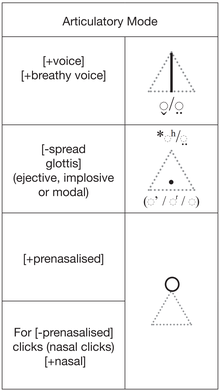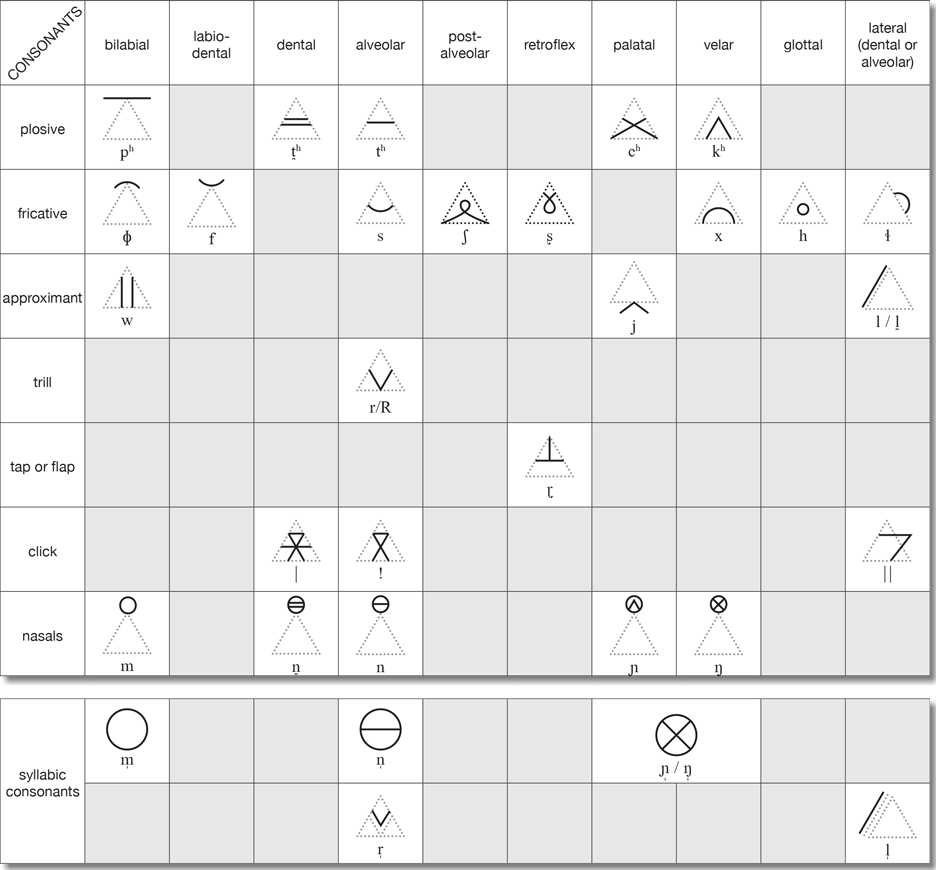Ditema tsa Dinoko
| Ditema tsa Dinoko isiBheqe soHlamvu | |
|---|---|
Featural syllabary
| |
| Languages | ideographs (Izimpawu zesiNtu)
|
Ditema tsa Dinoko (
The Ditema / Isibheqe syllabary has the capacity to represent the full phonological range of these sintu languages (in the

Description
The script operates as a

Vowels
The vowel graphemes (onkamisa) form the basis of each ibheqe or syllable block, as the nucleus of each syllable, with the ongwaqa or consonant graphemes positioned in and around them.
The direction of each ibheqe indicates the quality of the vowel for each of the seven vowel
- Intombi, the upward facing triangle: /i/
- Isoka, the downward facing triangle: /a/
- Umkhonto, the upward facing chevron: /u/
- The leftward facing triangle: /ɛ/
- The rightward facing triangle: /ɔ/
- The leftward facing chevron: /e/
- The rightward facing chevron: /o/
There is an eighth "vowel" represented by the downward facing chevron, which is an empty vowel, and is mostly used for foreign words to represent a standalone consonant, often as a
The apex of the triangle or chevron corresponds to vowel height or frontedness, with
Vowel nasality is indicated with the ingungwana grapheme, which is a solid dot outside the triangle separated from the apex, as in the word phãsi below:

| English | down/below | |
|---|---|---|
| Zunda | phansi |
 |
| Tekela | phãsi |
 |
Consonants
Consonants (ongwaqa) are composed of one or more graphemes. At least one of these indicates the place and manner of articulation. If more than one such consonant grapheme is superimposed, this represents a co-articulation, e.g. an
The position of the consonant graphemes largely corresponds to the place of articulation:
- Labials and nasals are positioned outside the triangle at the apex.
- Alveolars are across the middle of the triangle from side to side.
- Velars and palatals are at the base.
- Laterals are outside the triangle on one side.
- Dentals are two lines across the triangle from side to side, parallel to each other.
The shape of the consonant grapheme corresponds to the manner of articulation:
- Curved lines indicate fricatives.
- Their straight line counterparts in the same positions indicate plosives.
- tap or flapbeing the latter arrangement, one line bisecting the other at its centrepoint without crossing it.
- postalveolarfricatives are represented as loops.
- Nasals are represented as circles at the apex of the triangle. Lines inside the circles distinguish the nasals from each other.
- Clicks are a bottomless hourglass shape.
- Affricates are spelled by placing both the corresponding stop and fricative graphemes in the triangle. Onset clusters use the same technique.
- Syllabic laterals and trills are represented with duplication of the ordinary lateral and trill graphemes.
Syllabic nasals or amaqanda are unique in that they occupy the entire ibheqe space as circles. They are distinguished from each other with lines inside them that operate according to the same principles as above.
These graphemes can combine with each other in an order in accordance with the phonotactics of sintu languages, and they also can combine with the articulatory mode graphemes.
Articulatory mode

There are three graphemic markers of articulatory mode:
- For unvoiced consonants, a solid dot within the triangle indicates a glottalised (ejected) consonant or a modal click consonant.
- For voiced consonants the solid dot inside the triangle indicates an implosiveconsonant or, in the case of languages where there are no implosives, a modal consonant.
- The absence of the dot indicates breathy voice in the case of voiced consonants, and aspiration in the case of voiceless consonants.
- Uphimbo, or the voicing line, running from the apex of the triangle to the base (or until inline with the ends of the chevron), indicates consonant voicing.
- If the voicing line occurs as the only ungwaqa in the ibheqe, it indicates a voiced glottal fricative /ɦ/.
- In languages that distinguish between breathy voiced and modal nasals/trills, the voicing line indicates breathy voice when occurring with these consonant graphemes.
- bilabial nasal/m/ that occurs on its own. No additional lines need be added to the ingungu when it occurs with other ongwaqa as the place of articulation is given by them and need not be marked in the nasal grapheme.
- For clicks, the ingungu marks a nasal click consonant, with the prenasalised clicks (e.g. <nkq>) requiring the addition of a solid dot (glottalisation), in which case the ingungu denotes prenasalisation.[9]
References
- ^ "isiBheqe". isibheqe.org. 23 August 2015. Archived from the original on 8 February 2016. Retrieved 16 September 2015.
- ^ "Isibheqe Sohlamvu: An Indigenous Writing System for Southern Bantu Languages" (PDF). linguistics.org.za. 22 June 2015. Archived from the original (PDF) on 4 March 2016. Retrieved 16 September 2015.
- ^ Writing Systems Archived 2018-06-27 at the Wayback Machine (12 May 2017) "Perhaps the most contemporary and creative African script is known as Ditema Tsa Dinoko (Isibheqe Sohlamvu in Zulu). This script can be used to write any Southern Bantu language, such as Sesotho, Zulu, and Tswana. The Southern Bantu languages are found in South Africa, Botswana, Mozambique, and Zimbabwe. Created within the past three years by linguists, programmers, and designers, this special writing system is inspired by traditional litema art of Lesotho." See also e.g.: "Isibheqe cabinets". Design Miami. Retrieved 2015-11-23.
- ^ van Niekerk, Garreth (2016-02-08). "Indigenous alphabet on the cards for SA". City Press (South Africa). Archived from the original on 2021-07-14.
- (PDF) from the original on 2020-08-03.
- ^ "Update on Usage and Implementation Status of African Scripts." Unicode, Inc. 8 September 2023. Retrieved 5 February 2023. p. 6.
- ^ isibheqe.org (2015). "Isibheqe Sohlamvu/Ditema tsa Dinoko". isibheqe.org. Archived from the original on 2016-02-08. Retrieved 2016-09-11.
- ^ "Ingcazo". isibheqe.org. Archived from the original on 2018-10-16. Retrieved 2016-09-11.
- ^ "Incazo Yohlelo". isibheqe.org. 23 August 2015. Retrieved 16 September 2015.[permanent dead link]
External links
- Ditema (Ditema tsa Dinoko / Isibheqe Sohlamvu) at Omniglot
- Ditema tsa Dinoko at isibheqe.org.za



